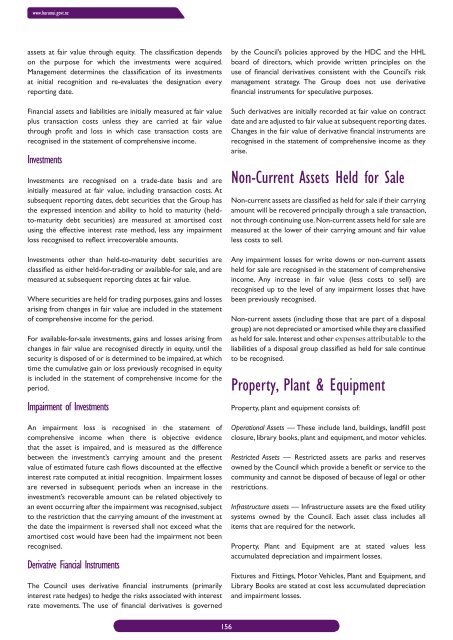Long Term Community Plan 2012-2022 - Hurunui District Council
Long Term Community Plan 2012-2022 - Hurunui District Council
Long Term Community Plan 2012-2022 - Hurunui District Council
Create successful ePaper yourself
Turn your PDF publications into a flip-book with our unique Google optimized e-Paper software.
www.hurunui.govt.nz<br />
assets at fair value through equity. The classification depends<br />
on the purpose for which the investments were acquired.<br />
Management determines the classification of its investments<br />
at initial recognition and re-evaluates the designation every<br />
reporting date.<br />
Financial assets and liabilities are initially measured at fair value<br />
plus transaction costs unless they are carried at fair value<br />
through profit and loss in which case transaction costs are<br />
recognised in the statement of comprehensive income.<br />
Investments<br />
Investments are recognised on a trade-date basis and are<br />
initially measured at fair value, including transaction costs. At<br />
subsequent reporting dates, debt securities that the Group has<br />
the expressed intention and ability to hold to maturity (heldto-maturity<br />
debt securities) are measured at amortised cost<br />
using the effective interest rate method, less any impairment<br />
loss recognised to reflect irrecoverable amounts.<br />
Investments other than held-to-maturity debt securities are<br />
classified as either held-for-trading or available-for sale, and are<br />
measured at subsequent reporting dates at fair value.<br />
Where securities are held for trading purposes, gains and losses<br />
arising from changes in fair value are included in the statement<br />
of comprehensive income for the period.<br />
For available-for-sale investments, gains and losses arising from<br />
changes in fair value are recognised directly in equity, until the<br />
security is disposed of or is determined to be impaired, at which<br />
time the cumulative gain or loss previously recognised in equity<br />
is included in the statement of comprehensive income for the<br />
period.<br />
Impairment of Investments<br />
An impairment loss is recognised in the statement of<br />
comprehensive income when there is objective evidence<br />
that the asset is impaired, and is measured as the difference<br />
between the investment’s carrying amount and the present<br />
value of estimated future cash flows discounted at the effective<br />
interest rate computed at initial recognition. Impairment losses<br />
are reversed in subsequent periods when an increase in the<br />
investment’s recoverable amount can be related objectively to<br />
an event occurring after the impairment was recognised, subject<br />
to the restriction that the carrying amount of the investment at<br />
the date the impairment is reversed shall not exceed what the<br />
amortised cost would have been had the impairment not been<br />
recognised.<br />
Derivative Fiancial Instruments<br />
The <strong>Council</strong> uses derivative financial instruments (primarily<br />
interest rate hedges) to hedge the risks associated with interest<br />
rate movements. The use of financial derivatives is governed<br />
by the <strong>Council</strong>’s policies approved by the HDC and the HHL<br />
board of directors, which provide written principles on the<br />
use of financial derivatives consistent with the <strong>Council</strong>’s risk<br />
management strategy. The Group does not use derivative<br />
financial instruments for speculative purposes.<br />
Such derivatives are initially recorded at fair value on contract<br />
date and are adjusted to fair value at subsequent reporting dates.<br />
Changes in the fair value of derivative financial instruments are<br />
recognised in the statement of comprehensive income as they<br />
arise.<br />
Non-Current Assets Held for Sale<br />
Non-current assets are classified as held for sale if their carrying<br />
amount will be recovered principally through a sale transaction,<br />
not through continuing use. Non-current assets held for sale are<br />
measured at the lower of their carrying amount and fair value<br />
less costs to sell.<br />
Any impairment losses for write downs or non-current assets<br />
held for sale are recognised in the statement of comprehensive<br />
income. Any increase in fair value (less costs to sell) are<br />
recognised up to the level of any impairment losses that have<br />
been previously recognised.<br />
Non-current assets (including those that are part of a disposal<br />
group) are not depreciated or amortised while they are classified<br />
as held for sale. Interest and other expenses attributable to the<br />
liabilities of a disposal group classified as held for sale continue<br />
to be recognised.<br />
Property, <strong>Plan</strong>t & Equipment<br />
Property, plant and equipment consists of:<br />
Operational Assets — These include land, buildings, landfill post<br />
closure, library books, plant and equipment, and motor vehicles.<br />
Restricted Assets — Restricted assets are parks and reserves<br />
owned by the <strong>Council</strong> which provide a benefit or service to the<br />
community and cannot be disposed of because of legal or other<br />
restrictions.<br />
Infrastructure assets — Infrastructure assets are the fixed utility<br />
systems owned by the <strong>Council</strong>. Each asset class includes all<br />
items that are required for the network.<br />
Property, <strong>Plan</strong>t and Equipment are at stated values less<br />
accumulated depreciation and impairment losses.<br />
Fixtures and Fittings, Motor Vehicles, <strong>Plan</strong>t and Equipment, and<br />
Library Books are stated at cost less accumulated depreciation<br />
and impairment losses.<br />
156

















